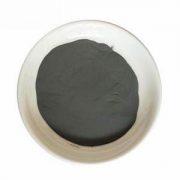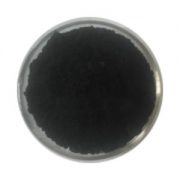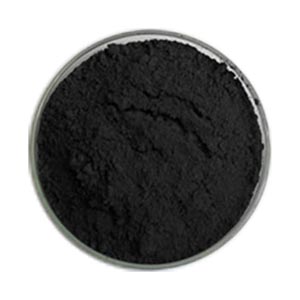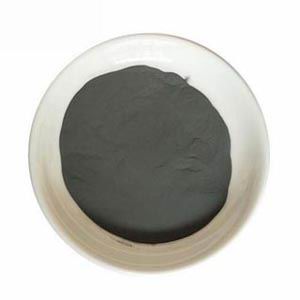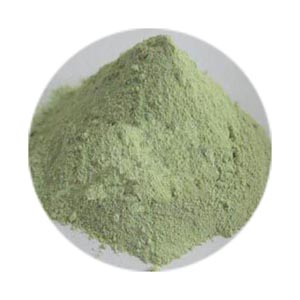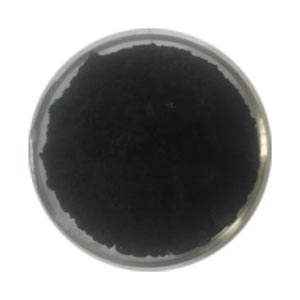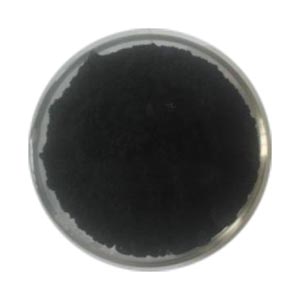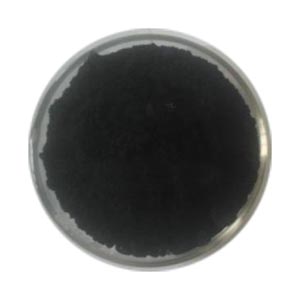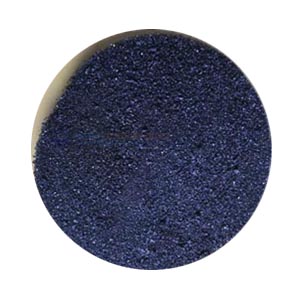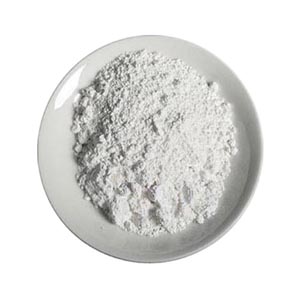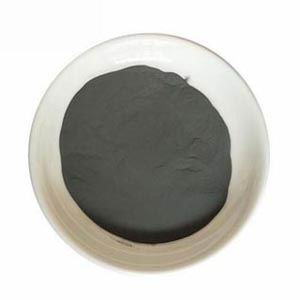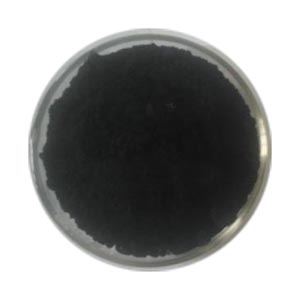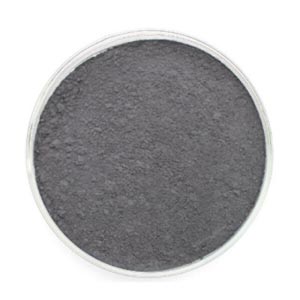
Molybdenum disilicide
Other name: Molybdenum silicide
Molecular formula: MoSi2
CAS number: 12136-78-6
Molecular weight: 152.11
Melting point: 2030 ° C
Density: 6.24g/cm3
- 描述
- Related Information
- Inquiry
Purity: 99.9%
Particle size: 1—3um
Appearance: Gray-black powder
Crystal form: Quartet
Thermal conductivity: 45W / m.K
Thermal expansion coefficient: 8.1 × 10 -6 K-1
Resistivity: 21.5 × 10 -6 Ω.cm
Vickers hardness (HV): 10.6Gpa
The basic characteristics of molybdenum disilicide powder:
MoSi2 has the high melting point and anti-corrosion and oxidation resistance of ceramics, as well as the electrical conductivity and high temperature plasticity of metal materials, and low specific gravity, which is the highest content of silicon in binary alloy system Mesophase, with dual properties of metal and ceramic. A promise of material production of molybdenum disilicide ceramic powder high purity, narrow particle size distribution, with good high temperature oxidation resistance, high temperature plasticity, thermal conductivity and fluidity in the field of high temperature structural ceramics has a wide range of applications.
The main purpose:
1) For heating element, integrated circuit, high-temperature anti-oxidation coating and high-temperature structural material, its main purpose is to make the heating element work in oxidizing atmosphere.
2) used in the glass furnace to do fused glass electrode, bubble tube, thermocouple protection tube, gas sampling tube;
3) For thick-film resistors, conductive anti-oxidation coatings, integrated circuit films, etc .;
4) Gradient high temperature oxidation resistant coating for molybdenum disilicide based composite materials, such as high temperature structural parts and refractory metals;
5) Matrix for structural composites, and reinforcements for other structural ceramics;
6) For the production of ceramic products, sputtering targets and so on.
Preparation and properties of molybdenum disilicide
1.Dip coating method (coating thickness problem)
Graphite mill was made into 15mm * 15mm * 15mm * of the block, the use of CSF-1A-type ultrasonic cleaning of its surface cleaning, drying and spare.
According to a certain percentage of Si powder, water and polyvinyl alcohol formulated into a slurry, grinding in a ball mill 1h. The graphite block was coated with a slurry of about 500 μm thickness by dip coating. After drying at 110 ℃ for 12h and then in a vacuum furnace at 1450 ℃ for 2h, a graded SiC inner coating can be prepared on the graphite substrate.
According to a certain percentage of weighing Mo powder and Si powder, Si-Mo slurry was prepared using the same process described above. The Si-Mo slurry was coated on the inner SiC layer by dipping method. The Si-Mo slurry pre-coating with different thickness was coated on the inner SiC layer by controlling the number of dip-coating of Si-Mo slurry. Dried at 110 ° C for 12 h and then calcined at 1420 ° C for 2 h in a vacuum resistance furnace.
Properties: (1) The outer layer thickness of Si-MoSi2 has great influence on the oxidation resistance of the prepared SiC / Si-MoSi2 coating.
(2) After the coating is oxidized, a complete and dense SiO2 glass layer is formed on the surface of the coating, which is the fundamental reason for the improvement of the oxidation resistance of the material
2.liquid silicon penetration and slurry sintering method (plasma spraying)
Mo and Si powder as raw materials, according to Mo: Si = 1: 2 (atomic ratio) in a blender for 24h, the mixed powder synthesized by high temperature self-propagating under argon atmosphere MoSi2 powder as a spray coating One of the powder The self-propagating high-temperature synthesis of MoSi2 powder by granulation and vacuum heat treatment to obtain spray coated agglomerate powder. Preparation and Microstructure Analysis of MoSi2 Coatings: Based on K403 nickel base alloy, the size of which is 10 mm × 15 mm, the surface of the base material is degreased, de-rusted and sandblast cleaned. Using APS-2000 air plasma spraying equipment, the self-propagating synthetic powder and agglomerate powder were used as raw materials for spraying. The spraying process parameters were: power 50kW, relative distance between spray nozzle and sample 150 mm, argon flow rate 40 L / min, Powder feeding rate of 18 g / min. The phase composition of MoSi2 powder and coating was measured by D8-Advance X-ray diffractometer. The microstructure of coating was observed by JSM-6380LV scanning electron microscope.
Properties: (1) For the agglomerate powder, the MoSi2 coating is mainly composed of MoSi2 and contains only a small amount of Mo5Si3 phase and a very small amount of Mo phase, and its phase composition is better. (2) Under the same spray process parameters, the particle size is too large, will lead to poor melting of the particles, making the porous coating loose; if the particle size is too small, the particles can be fully melted, but the nozzle to the sample during flight Serious oxidation occurs, leading to more white areas in the coating cross-section, that is, more molybdenum-rich phase is produced, which is not conducive to the preparation of a coating with better phase composition.
3 spark plasma sintering preparation method
(1) Kuchino et al. Mixed the Mo-Si powder at a atomic ratio of 1: 2 into a graphite mold and placed the graphite mold in a vacuum chamber at 6 Pa to apply a pressure of 40 MPa to the mold, Pulse current was 0.17 ℃ / s, the maximum sintering temperature was 1 400 ℃, and the MoSi2 material with a density of 99% was synthesized in-situ for 600 s. The dense MoSi2 contained a small amount of SiO2. MoSi2 powder as raw material, the same process is also synthesized with a density of 99% of the material, the synthesis of the material in the accelerated oxidation zone (400 ~ 700 ℃) has good oxidation resistance.
(2) Shimizu et al. Prepared the MoSi2 powder by the SHS process, and then sintered it at a pressure of 1 254 ° C. and a pressure of 30 MPa in an SPS apparatus for 10 min to prepare a compact glass with a density of 97.3%, a crystal grain size of 7.5 μm, Hardness of 10.6 GPa, fracture toughness KIC of 4.5 MPa · m1 / 2, the flexural strength of 560 MPa of the material.
(3) Krakhmalev and other high-energy ball milling of raw materials, and then SPS sintering were obtained C40 Mo (Si0.75Al0.25) 2, Mo (Si0.75Al0.25) 2 / SiC, Mo .75Al0.25) 2 / 0,10,20,30% (volume fraction) Al2O3 and Mo (Si0.75Al0.25) 2 / ZrO2 composites.
Spark Plasma Sintering (SPS) is still a relatively new process. As can be seen from the above study, this process can obtain a relatively dense matrix material and can be used for preparing composite materials. Such a process has not been widely used in the preparation of MoSi2 , So the material performance improvement is not very obvious. However, compared with other preparation methods, the properties of pure MoSi2 have been greatly improved. Because of its high density, at least to prevent MoSi2 low-temperature "Pesting" phenomenon, so the future of this process should be greatly developed.
相关产品
-
Titanium black Ti4O7
Blue Black electrically conductive powder
Produced by proprietary process
High Ti407 Content
Structurally Stabilized Sheer Planes
High Resistance to oxidation and corrosion
in acid and base solutionsStabilized Magneli Phase Titanium Oxide
Electrically Conductive Ceramic PowderD50 particle size: 80nm, 20um
-
Tungsten silicide
Other name: Tungsten disilicide
CAS no. : 12039-88-2
EINECS no. : 234-909-0
Formula: Si2W.
Molecular weight: 240.011
Density: 9.40 g/cm3
Melting point: 2165 C.
-
Zirconium tungstate
Other name:
Tungsten zirconium oxide ; Ditungsten zirconium octaoxide
CAS no. : 16853-74-0
EINECS no. : 240-876-3
Molecular formula: Zr(WO4)2
Molecular weight: 586.8992.
-
Nano vanadium dioxide VO2
Other name: Vanadium oxide; Dioxovanadium
Appearance: black powder
Grain size: 50nm, 100nm, 500nm
Purity: 99.9%, 98% ( tungsten mingle ) -
Niobium boride
Other name : niobiumbago (NBB); boranylidyneniobium
CAS no. : 12653-77-9; 12045-19-1
EINECS no. : 234-958-8
Formula: B2Nb.
Molecular weight: 103.7174.
Density: 7g/cm3
Melting point: 3050℃
-
Niobium diselenide
Other name: Niobium(IV) selenide, Niobium selenide; Columbium selenide; diselenoxoniobium; niobium(+4) cation; selenium(-2) anion
CAS no. : 12034-77-4
EINECS no. : 234-811-8
Formula: NbSe2.
Molecular weight: 250.8264.
Density (g/mL,25) : 6.3
-
Tungsten hexachloride
English alias: Tungsten (VI) chloride; Tungstenchloride; Tungsten (6 +) hexachloride; Tungsten (4 +) tetrachloride; Tungsten chloride
CAS no. : 13283-01-7
EINECS no. : 236-293-9
Molecular formula: Cl6W
Molecular weight: 396.558
Melting point: 275 ℃
-
Tantalum pentachloride
Other name: Tantalic Chloride, Tantalum(V) chloride, Tantalumchlorideanhydrous
CAS no. : 7721-01-9
EINECS no. : 231-755-6
Molecular formula: Cl5Ta
Molecular weight: 358.2145
Melting point: 221-235 ℃
Relative density :3.682
-
Tantalum diboride
Other name: tantalum boride (1:2)
CAS no. : 12007-35-1
EINECS no. : 234-234-5
Molecular formula: B2Ta.
Molecular weight: 202.572
-
Molybdenum pentachloride
Specification: 99%-99.99%
English alias: Molybdenum (V) chloride; Molybdenumchlorideanhydrous; Molybdenum (V) chloride
CAS number: 10241-05-1
Molecular formula: MoCl5
Molecular weight: 273.205
Melting point: 194°C

